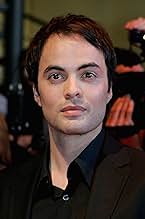Adicionar um enredo no seu idiomaA portrait of Austrian artist Gustav Klimt, whose lavish, sexual paintings came to symbolize the art nouveau style of the late nineteenth and early twentieth century.A portrait of Austrian artist Gustav Klimt, whose lavish, sexual paintings came to symbolize the art nouveau style of the late nineteenth and early twentieth century.A portrait of Austrian artist Gustav Klimt, whose lavish, sexual paintings came to symbolize the art nouveau style of the late nineteenth and early twentieth century.
- Direção
- Roteiristas
- Artistas
- Prêmios
- 1 vitória e 4 indicações no total
- Direção
- Roteiristas
- Elenco e equipe completos
- Produção, bilheteria e muito mais no IMDbPro
Avaliações em destaque
The other actors are notable European actors whose works have generally not been seen in the United States. The notable German actress Veronica Ferres portrays Emily Floge; Klimt's lifelong companion. Again, unless you are familiar with the life of Klimt the role of Floge in this movie is very difficult to understand. And, it is never explained in the movie. Basically, Klimt and Floge were in-laws by the marriage of Gustav's brother to Emily's sister. The seemed to never have been "lovers" but the unmarried Emily seems to have been a wife (as well as business partner) to Gustav in every other respect. It was a complex relationship and Ferres explains in a side featurette ("The Making of Klimt") the difficulty of showing this relationship. The Austrian actress Aglaia Szyszkowitz portrays "Mizzi"; a model who bore two kids for Klimt of which one is shown- his son Gustav. He never married her, and the movie implies that he saw his kids only occasionally without financially supporting them in any noticeable manner. In real life Klimt did financially support his children by this woman. Of note is that the nickname for Emily Floge was "Middi" and the pronunciation of the two names is very similar; adding to the already considerable confusion.
The movie does portray Klimt in a negative manner concerning his offspring. He acknowledged paternity of four children and the movies deals with the other two as well as the two of Mizzi. Those children are dealt with almost as afterthoughts and one is positively embarrassing (perhaps the ultimate embarrassment). In reality Klimt probably had many more kids and this concern is mentioned briefly in the film. The film is certainly critical of Klimt in this regard; as well as his attitude towards women in general. There are some historical inaccuracies in this film such as a nurse in a Vienna hospital in early 1918 who has a VERY obvious British accent. This is highly unlikely, to say the least, to have been the case considering that the Austrians were in war with the British at that point, but overall the historical settings and costumes are well researched. The movie overall is well researched, but, again, quite confusing to somebody who is not very familiar with the life of this genius. I recommend that anybody who wants to see the film to first read up and look at the artworks of Klimt. Then the film will make sense and be seen as the superb achievement it is.
I didn't like this movie, and I have to say I admire Klimt paintings. I don't think that Klimt was so stiff and also sleepy. There is much more life in one simple photograph from the artist Wiki page, than in this whole movie. All these endless camera rotations around subjects! And too much too loud music... And actually an absence of scenario...
They tried to sell this movie to public - nudes, decadent atmosphere, this misleading label. The ratings show that they failed... I give it 5 for some visual enjoyment I had... and some women hats there were really-really amazing!
There's a commonality among those two and Klimt, and even between them and the more cerebral Budapest next generation. Its a matter of passion, sense (in both meanings) and concept curvature. While the two great art nouveau geniuses were wondering about space in Brussels and Barcelona, Klimt worked his space, curvature ans escape from the inside of women. Lots of women.
His work is of that type that is immediately attractive, so lots of people decorate with it. A brief familiarity with it breeds confusion, so unless you dig as deeply in viewing as he did in making, it will not connect. As a result, if you are serious about making a film of him, about him, you simply cannot do the normal thing: somehow artificially inducing drama into portraying a few known events. You cannot do what Greenaway did with Rembrandt, simply showing sexual passion and making the film painterly.
So along comes Ruiz, who is a strange bird, very much like Klimt. There's no middle familiarity with him. Either you know him deeply, you wrap your life where he has, or you miss the passion. You think him dull. You actually believe that someone would spend this much energy fine tuning the ordinary. Well, the thing about these three men is that they were their own worst critics. They all three created their own new worlds were none was before, worlds so perfect and pure anyone of lesser power would be unable to break them. Then they each turned on their own creation, finding and exploiting the weaknesses of their own creations, selves and now us. The art is not in the man but in how he made himself broken.
Look at each of them and see the beauty in partial dismemberment. Ruiz denotes this at the beginning with otherwise inexplicable, powerful amputee sex. As with Ruiz' best work, people act as others, split selves, whores of themselves, auditors and bureaucrats of sex. Love must be dissymmetric. Narrative to have power must be a bit jagged inside, where you want to go.
I admit, I think Malkovich was a bad choice. He really can be dull. But he is supposed to stagger through this, finding puddles of warm light, clean frames or open enclosure. The women are the thing, always the thing here and they are drawn well.
Ted's Evaluation -- 3 of 3: Worth watching.
Hunter S. Thompson blew the journalistic world away by openly reporting events through the prism of his own drug-soaked experience. Terry Gilliam's cinematic portrayal of this in "Fear and Loathing in Las Vegas" conveyed this brilliantly.
So far as I know, Gustav Klimt did not portray his artistic vision in an ether-soaked stupor or in a state of syphilitic delirium. My problem with Mr. Ruiz portraying him as though he did is that Klimt actually led an exuberant revolutionary artistic movement in a city and continent exploding with creative energy, and this portrayal could hardly be farther from the truth. Even a non-linear poetic portrayal of the creative process should shed some truth on its essence.
The tone of the movie was static, suffocating, semi-conscious and joyless. Klimt's life was full of color, sexual experimentation and living life to its fullest, so it additionally seems odd that John Malkovich sleepwalks through his performance with less joy than Rod Steiger in "The Pawnbroker."
If Mr. Ruiz wanted to make a film about a fever-dream (Klimt died of pneumonia following a stroke, not of tertiary syphilis as suggested in the film), perhaps he should have entitled it "Fever-Dream: with a whimsical guest appearance by my fantasy of Gustav Klimt."
This film may be of use to film students to prove that images and sound do not automatically add up to a movie.
The movie is decorated with dozens of naked women who mainly parade about, or who try to seduce Klimt. Given that he is not particularly handsome, charming or intelligent, I failed to see the attraction. Perhaps it was just his fame as a painter.
The interiors and costumes are opulent turn of the century Vienna. Elaborate Viennese pastries tempt the eye. The sets are the main appeal of the movie.
There is a lot of cat and mouse dialogue where the characters reveal nothing and say nothing while attempting to sound profound. It is all quite frustrating.
Nikolai Kinski plays the homosexual painter Egon Schiele in an exaggeratedly swish way, reminiscent of Da'an's hand gestures in Earth Final Conflict.
The costumes and hair treatments are so elaborate, that I could not for the life of me tell the female characters apart. Is this a new character or an old one in a new do? The characters all behave the same way and look similar. I didn't develop any bond with any of the characters because I could not even tell them apart.
Você sabia?
- CuriosidadesRyan Phillippe was considered for the role of Klimt.
- Erros de gravaçãoWhen Klimt mashes the cake in the man's face, the icing on the man's face is not covering his right eye. In the next close-up shot, there is a large blob of icing covering the man's right eye. In the next long shot when Klimt starts to wipe the man's face, the icing is no longer covering the man's right eye again.
- Citações
Klimt: Who art thou Asked the guardian of the night From crystal purity I come Was my reply And great my thirst, Persephone Yet heeding thy decree I take to flight and turn, and turn again Forever right I spurn the pallid cypress tree Seek no refreshment at its sylvan spring but hasten on toward the rustling river of Mnemosyne Wherein I drink to sweet satiety And there, dipping my palms between The knots and loopings of its mazy stream I see again, as in a drowning swimmers dream All the strange sights I ever saw And even stranger sights no man has ever seen
- Versões alternativasA 131-minute-long Director's Cut was released theatrically in Austria and is available on DVD in the UK.
- ConexõesReferenced in Ricardo Aronovich, avec mes yeux de dinosaure du cinéma (2011)
Principais escolhas
- How long is Klimt?Fornecido pela Alexa
Detalhes
- Data de lançamento
- Países de origem
- Centrais de atendimento oficiais
- Idiomas
- Também conhecido como
- A Viennese Fantasy à la manière de Schnitzler
- Locações de filme
- Empresas de produção
- Consulte mais créditos da empresa na IMDbPro
Bilheteria
- Faturamento bruto nos EUA e Canadá
- US$ 97.656
- Fim de semana de estreia nos EUA e Canadá
- US$ 2.332
- 24 de jun. de 2007
- Faturamento bruto mundial
- US$ 584.991
- Tempo de duração2 horas 11 minutos
- Cor
- Mixagem de som
- Proporção
- 1.85 : 1
Contribua para esta página





































